Earlier this month, the Korean media ignored a Free the Nipple event held by Womenlink. This lack of coverage is just one reason why the campaign may struggle to take-off in Korea. But stranger things have happened. Once, men too were forbidden from exposing their chests in public. As Korean summers get hotter and drier, soon these double-standards may seem as absurd as no-pants laws and the skirt-length police.
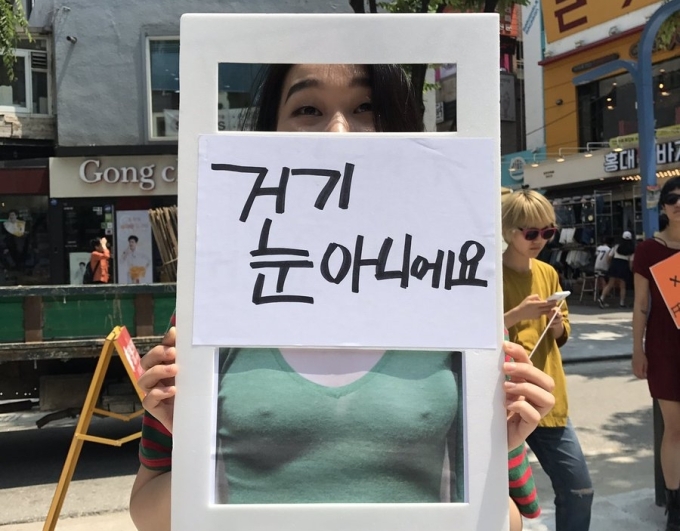 Estimated reading time: 25 minutes. Image source: @womenlink
Estimated reading time: 25 minutes. Image source: @womenlink
Boobs don’t get much love in Korea.
If they’re larger than average, their owners are often criticized for flaunting their femininity, and stereotyped as sexually voracious. Those same women also struggle to find comfortable, attractive bras that will fit them.
This, despite Korean women’s breasts getting larger for decades as Koreans’ diets have changed.
Of course, women the world over struggle with these issues. But it’s not just size, it’s exposure in general, and standards in Korea are that much stricter. As I’m no Picasso explains:
“Base line standard in Korea: If you are showing even the tiniest centimeter of a crack of cleavage, you are not dressed appropriately for work. Shoulders are also largely taboo, although we have noticed this changing a bit this past summer. Even too much exposed skin on the chest above the cleavage mark can be considered risque.
It’s a pain in the ass for girls with larger chests, because it’s really difficult to find garments that won’t show any cleavage, no matter what position you are in. I’ve also had to take to having an army of undershirts on hand, in order to be sure that not even the shadow of a bra can be seen…”
That probably explains why, per capita, more Korean women plump for breast reductions than enlargement or lifting operations. Also, why bust-reducing bras are so popular, despite Northeast-Asian women’s genetic tendency to have much smaller breasts than—for want of a better catch-all term—Western women. I suspect why bralettes—which can only be really worn by women with small breasts—haven’t been available in Korea either, as Korean women may not have considered them concealing enough. (Although this recent campaign to start producing them has been very successful, and this Japanese-sourced one is also making waves.)
In the midst of this, the Korean media and K-pop industries occupy ambivalent positions. On the one hand, the latter stumbled onto a strategy of emphasizing female performers’ legs instead, considered a “safer” body part in Korea and its Asian markets (well illustrated by this classic cartoon, and the surprising modesty of these “sexy dances“), which simultaneously sexualized the girls and women while deflecting criticism. On the other, the entire industry is centered around securing endorsement contracts with the advertising and beauty industries, which have vested interests in creating new markets through encouraging bustier, more revealing beauty standards.
 Image Source: Rok Kim. Anonymous source (quoted with permission): “What are you, ladies? Personally I am 가슴 B컵 for Boobs Are Great In All Sizes and 얼굴 F급 for Fucks Given About Your Opinion Are Zero.” (Advertisement Caption: Breasts, D-cup; Face, A-grade.
Image Source: Rok Kim. Anonymous source (quoted with permission): “What are you, ladies? Personally I am 가슴 B컵 for Boobs Are Great In All Sizes and 얼굴 F급 for Fucks Given About Your Opinion Are Zero.” (Advertisement Caption: Breasts, D-cup; Face, A-grade.
But these are all necessary generalizations. The reality is messy, undercut by age, class, marital status, motherhood, occupation, and region. Every morning while working on this post, the range of women’s fashions and levels of exposure I witnessed even just on the subway would defy any of the neat conclusions I’d arrived at the night before.
So, two weeks of pondering nipples and breasts later, as one does, the only generalization I’m still confident of making is that all women suffer from the inconveniences—and, ultimately, the dangers—of the double standards of men’s and women’s fashion.
Most of the negative effects I’m aware of have been covered in those earlier links. But I also happen to be a guy, so I would appreciate female readers’ input. One I didn’t know about for instance, because I don’t shop for women’s clothes, one anonymous woman told me:
“When I came back here 5 years ago, I was shocked because…dresses and/or skirts were way too short in general even when they were meant for the ‘office look’. When you buy clothes online, often the pictures are very misleading because companies often use very petite models so dresses/skirts look something of a normal length. I’ve learned it hard way and started to double-check the length. Nowadays I tend to stick with only a few sites when I shop my work clothes. I should probably start exploring offline stores again.
I don’t mind sporting short skirts/dresses every now and then when time & place is right—I just don’t wanna be surprised when I expect to receive something in a normal length for my work.”
Continuing, I’ve just been wearing short-sleeved shirts to work for the last month, and just long-sleeved shirts before that. In contrast, as a Womenlink activist wrote on her placard at the event (see below), women always have to wear unventilated padding to hide their nipples; to wear bras to hide their breasts; to wear vests to hide their bras; and to wear t-shirts to hide their vests.
No wonder my very well-developed, very active 11 year-old daughter is so reluctant to make the transition from her flimsy training bras. Fortunately though, her school has no uniform, whereas many schools that do have one end up slutshame their female students and forcing them to wear such uncomfortable clothing.
Even more alarmingly, in one 2013 survey of Korean police officers, over half considered revealing clothing to be a cause of sexual assault (indicating little had changed from back in 1996). To those who would make fun of and dismiss Free the Nipple and Slutwalk campaigns in response to such attitudes, and continue to police women’s bodies so unfairly, I’m genuinely curious as to where they would draw the lines. Especially if they claim to still support women’s rights. For to whom else but misogynists, could so much shame and blame hinge on an exposed bra strap or visible nipple?
 “I dropped a lot of money on a nice bra…one with frills and made of lace, not like all my other ones that I bought from Uniqlo.” / “Minju! You can see your entire bra! Don’t wear a white t-shirt!” Source, above and below: @bambooblock
“I dropped a lot of money on a nice bra…one with frills and made of lace, not like all my other ones that I bought from Uniqlo.” / “Minju! You can see your entire bra! Don’t wear a white t-shirt!” Source, above and below: @bambooblock
 “But what about her? That’s the fashion!!” / Fashion you say… / Jeez… [put this on].” Ironic coincidence: this picture of Korean duo Love X Stereo appeared in my Facebook feed as I was translating!
“But what about her? That’s the fashion!!” / Fashion you say… / Jeez… [put this on].” Ironic coincidence: this picture of Korean duo Love X Stereo appeared in my Facebook feed as I was translating!
But where did these attitudes come from? Again, the question is more difficult than it appears, and there’s no handy introduction akin to Laura Miller’s “Mammary Mania” chapter in her excellent book on Japanese body aesthetics.
So, I spent most of those last two weeks laying the framework for what may be my own equivalent chapter on Korea someday. Allow me to present the fruits of that research, in the form of themes and trends I’ve identified that any answer must cover, as well as some highlights from new sources I’ve discovered (please let me know if you have any difficulty obtaining copies of the journal articles). As you’ll soon see, there’s a lot of things to consider, and it can be very difficult—even naive and counterproductive—to separate nipple and breast exposure from taboos surrounding other body parts:
• For a discussion of late Joseon Dynasty art, notions of eroticism, and dress codes, as well as a great introduction to a painter who turned out to be quite a maverick and social commentator for his time, see Saehyang P. Chung’s “Sin Yunbok’s Women on Tano Day and the Iconography of Common women Washing Clothes by a Stream,” Oriental Art, vol. 47, no. 5 (2001), pp. 55-69. For instance, consider Chung’s description of Women on Tano Day, painted at the turn of the 18th and 19th centuries (p. 56; my emphasis):
“[Most striking of all] is the provocative portrayal of semi-nude bathers in the lower left-hand corner, where a woman stands sensually, her face turned in the direction of the beholder. Equally daring is the inclusion of two young monks, who observe the bathers with unequivocally frank poses and facial expressions…Considering that even in the West, the female nude in a contemporary setting—devoid of classical or biblical context (e.g. Diana or Susanna in Her Bath)—did not appear until the 19th century, the representation of bathing women in Sin Yunbok’s painting is all the more remarkable.“
 Source: Wikipedia
Source: Wikipedia
• You may have noticed that the working woman carrying a load on her head is fully-clothed, but has her breasts exposed. This is because, as explained by Hyung Gu Lynn in “Fashioning Modernity: Changing Meanings of Clothing in Colonial Korea” in the Journal of International and Area Studies (2004; pp. 77-78):
“…during the Chosôn period, clothing was not a unifying medium for all Koreans, but rather a means of social differentiation. Considerable scholarly energy has been directed to the study of the regulations that governed what clothes and colors could be worn by [whom]. The results show, for example, that it was only women of the upper class who wore long coats and head covers called chang-ot when venturing outside. In contrast, commoner women who worked outdoors often wore short chôgori [blouses], which left their breasts exposed for ease in nursing their babies.”
• In light of the symbolic and unifying role the hanbok plays for most Koreans today, unfortunately there has been considerable opposition to acknowledging that “uncivilized” aspect of Korean fashion history. For more on the controversy, see “The Bare Facts” by Robert Neff and “Time to sex up Hanbok” by Andrew Salmon at the Korea Times, this AskHistorians thread at Reddit, the comments to this well-known photograph from 1945 (update: also, the comments to this 1920s breastfeeding postcard), “Joseon girls gone wild” at ZenKatsuo, and From Fukuoka for more photos.
• For a bare-breasted photography series inspired by—and in some cases directly replicating—Sin Yun-bok’s painting, see The Hanbok Project by photographer Kim Jung-nam and hanbok designer Lee Young-hee.
• In the chapter “Female Images in 1930s Korea: Virtuous Women and Good Mothers” in Visualizing Beauty: Gender and Ideology in Modern East Asia, ed. by Aida Yuen Wong (2012), Yisoon Kim notes that women were infrequently depicted in Korean art, even compared to other Confucian societies, but the new “Paintings of Colonial Women” genre exemplified by Sin Yun-bok briefly changed all that. What she writes about the anonymous picture on the left below however, contradicts the notion that breasts were not at all eroticized, a notion further corroborated by “firm breasts” being included in contemporary lists of beauty ideals (p. 93.):
 Sources: Naver, Daum, Vosub. On the right is a poster for the fanciful 2008 movie Portrait of a Beauty, which re-imagines Sin Yun-bok as a woman in disguise.
Sources: Naver, Daum, Vosub. On the right is a poster for the fanciful 2008 movie Portrait of a Beauty, which re-imagines Sin Yun-bok as a woman in disguise.
“…[this left] picture recalls Sin Yun-bok’s style except for the absence of ornate hair accessories. Donning a short skirt, which tantalizingly reveals the breasts, the woman lifts one hand to adjust her hairdo. Although the hanbok is designed to fully cover the body, these paintings expose the flesh in strategic places. Sin’s picture [in the center] includes a silver knife, a traditional symbol of chastity, hanging from the shirt as a reminder of the sexual potential of the image. [Paintings of this genre] facilitated carnal fantasy. They could be made to hang on walls like Western pin-ups or portable scrolls for the convenience of private viewing, presumably at men’s leisure.”
Perhaps it was the elite status of the women depicted that made all the difference? Or, if the women depicted were actually low-status gisaeng, because of the novelty of seeing them bare-breasted, as opposed to commoners?
• As Hyung Gu Lynn goes on to explain in her article, the adoption of Western clothing during the colonial period also had important class components, as well as becoming tied to anti-colonialism and nationalism. It’s difficult to understand the rise of—and misogyny against—the “New Woman” and “Modern Girl” ideals without those, so it’s worth quoting her at some length (p. 87, my emphases):
“[In addition to modernization bringing] increasing numbers of women out the house and into public spaces…the diffusion of technologies of visual reproduction and the development of the culture of tourism allowed for more men to consume more images of women, further multiplying the number of meanings embedded in a given piece of clothing.
Although increasing numbers of urban men wore Western-style suits, the changes in women’s clothing occurred at a far slower pace. The transition for women from Chosôn period ch’ima [skirt] to the “improved ch’ima” with the shorter skirt hem and the longer tops meant that the visual distinction between upper class women who had hidden under the chang-ot and the common women with exposed faces and breasts was eliminated. However, in the place of the exposed breast as a marker of commoner status, the degree of calf exposure became one of the indicators of female proximity to capitalism and modernity—more leg, more modern.
Students and workers were encouraged to wear shortened skirts and longer tops for their purported practicality in the more mobile world, but the exposed calf sparked heated debate over its sexual implications…The increased visual presence of women in public and the diffusion of romantic love imbued clothing with heightened sexual meaning.”
And (p.88):
“New styles of clothing which exposed more skin, legs in particular, influenced ideas of beauty that extended and encompassed to the shape of the female body. By the mid-1930s, articles on beautifying calisthenics for women that would not appear so out of place in twenty-first century magazines were appearing in the mass publications…Other articles introduced the proper way to put on makeup, what to wear for which occasions, and how to behave in the “modern life,” further supplementing the new definitions and ideals of beauty and grace. The changes in clothing clearly helped shape the sexual meanings imbued in various body parts, providing further evidence that the eroticized body parts and ‘proper’ areas of skin exposure changes with culture and time.
Developments in visual technology and tourism added to the intensified sexuality of clothing. Magazines, movie posters, and postcards distributed consumable images of women in various styles of dress…The complete covering of the female breast in the colonial period gradually eroticized what had previously been merely regarded a body part. The tourist and travel literature usually contained images of kisaeng in P’yôngyang, but in the late colonial period, the women sea divers in Cheju Island became increasingly popular subjects for postcards and photographs, usually pictured with their breasts exposed.
The ‘traditional’ ch’ima chôgori, which may have been the only clothes a Korean woman owned, or consciously wore as a symbol of resistance to colonial rule or as a reflection of class and status, could be perceived merely as an exotic costume by the unknowing male gaze. The multivalency of each piece of clothing allowed the ‘traditional’ female dress to symbolize Korean identity, and at the same time distend the exotic allure of travel in Korea by promising different vistas and enticing females to the male (predominantly Japanese) tourist.”
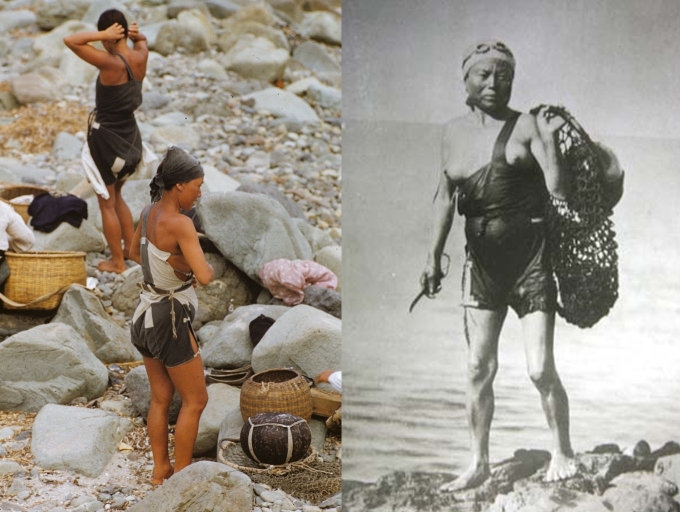 Sources: Sturmgeschutz, OhmyNews. Left image is actually of Busan divers.
Sources: Sturmgeschutz, OhmyNews. Left image is actually of Busan divers.
• Many years ago, I read that older Korean men (and women?) fondly remember those photos of semi-nude Haenyeo (Jeju divers) from when they were children, taken before the divers began wearing wetsuits in the 1950s and 1960s. Unfortunately, I’ve long since lost the source, so it was good to find indirect confirmation in Hyung Gu Lynn’s article. Actual examples of those photographs however, remain surprisingly difficult to find online, the vast majority actually being of Ama divers in Japan. But they’re out there. The one on the left below for instance, is part of a romanticized series from the 1950s according to the source, although the costumes are authentic; that later one on the right, very likely taken for a Jeju postcard, is much more modest, but remains a good example of glamorization and sexualization.
 Sources: 유자향내를 따라서, hansoo7007.
Sources: 유자향내를 따라서, hansoo7007.
• Yisoon Kim provides a good summary of why a new trend of portraying “virtuous” women then arose, with depictions of breastfeeding in particular becoming the main subjects of paintings for the first time (p. 91):
“…[the 1930s were] the height of colonialism, when conservatism and progressiveness coexisted…Fine artists tended to depict the opposites [of the much-criticized Modern Girls], that is, virtuous women who demonstrated chastity and sexual restraint. Modernization was underway…but unfavorable economic conditions inside and outside the country made Koreans wary of change. [Under the conditions of the Great Depression and coming war], the colonized and impoverished Korean nation took comfort in the idea of women carrying out their motherly duties and grooming the next generation for a more prosperous future.”
• In a previous chapter, “The Modern Girl as a Contested Symbol in Colonial Korea”, Yeon Shim Chung notes that other reasons for the adoption of the virtuous mother as a nationalist symbol include the facts that most of the new beauty products for the Modern Girls and New Women—as well as the original ideals themselves—came from Japan. Indeed (p. 82):
“Commerce and feminism intersected with colonialism in controversial ways. Korea’s access to Western goods was one vehicle for Japan to prove its utility as a civilizer and modernizer. As voracious consumers of these goods, Modern Girls inadvertently participated in Korea’s colonial subordination to Japan, which entailed [heavily] promoting [to both Koreans and to the West] progressive images of Japan while denigrating Korea as a remote, pre-industrial land…”
Which may have included bare-breasted women in hanbok, as the comment threads linked to earlier suggest, and why many Koreans’ understandable first reaction to seeing them is to dismiss them as Japanese propaganda.
• Most ordinary women entering the newly-created jobs open to them, of course, had no time for men’s criticisms of their newfound professional and sexual freedoms, or the shoehorning of their consumer purchases into narratives of nationalist betrayal. Indeed, as Young Na Kim describes in “Being Modern: Representing the ‘New Woman’ and ‘Modern Girl’ in Korean Art“, Western clothes became the norm by the 1930s (p. 222) “…not because they signified modernity, but because they were practical and comfortable.” Also, and in particular, further examples she gives caution against tendencies in previously mentioned sources that neatly categorize trends and depictions into the decadent 1920s vs. the virtuous 1930s (p. 238):
“One of the characteristics of the Modern Girl was her consciousness of her body. There were now attempts to freely express the physical strength or beauty of woman’s body. Nude paintings, which once were banned from being shown in public, now could be displayed at an exhibition with no restrictions, but they were still depicted in the setting of the artist’s studio. However, there is a photograph of famous dancer Choi Seong-hee [left, below] in 1931 which reveals that she exposed her body half naked in a public performance, as if to declare the freedom of the body. Kang Dae-sok’s photograph of a female nude [the first nude photograph in Korea; right, below] should be also noted in this context, in her stretched posture facing toward the sky as if to embrace the whole world, breaking away from the passive reclining or standing nude form.”
 Sources: knnews, 술취한★북극성.
Sources: knnews, 술취한★북극성.
• Moving rapidly to the postwar era, two easy guides I recommend on the transition to the full adoption of Western-style clothing are: Sunae Park et. al., “The Process of Westernization: Adoption of Western-Style Dress by Korean Women, 1945-1962” in Clothing and Textiles Research Journal, Vol. 11, Issue 3, 1993, which has more on the practical considerations behind the shift, and Karlyne A. Anspach and Yoon Hee Kwon, “Western Dress Styles Adopted by Korean Women” in Home Economics Research Journal, Vol. 4, No.4, June 1976.
• Next, there is the oft-mentioned mini-skirt fever prompted by singer Yoon Bok-hee, hemlines reaching a peak of 30cm above the knee in 1968. But in my opinion, the liberalization of Korean clothing and attitudes then is exaggerated. While more revealing imagery from the period tends to stick out, it may not be representative, not unlike the aforementioned wide gap between the busty ideals promoted by the Korean media and ordinary Korean women’s attitudes today. Also, not only was Yoon branded a “public enemy” for her bravado, and had eggs thrown at her the very same day she revealed her mini-skirt, but this was hardly the swinging ’60s in Korea. In fact, the country was desperately poor at the time (less than 1 in 10 Koreans had washing machines, refrigerators, phones, or televisions), with most of the public unable to spend much on fashion, and possibly deeply resentful of those that could.
Fears of the ensuing social conflict are one big reason for the implementation of the highly authoritarian “Yushin System” of 1972-1981, which included forced haircuts for men, minimum skirt-lengths for women, and strict censorship of sexual media content.
 Sources: Joongang Ilbo, 나르샤.
Sources: Joongang Ilbo, 나르샤.
• This censorship would not just end in the early-1980s however, but in fact sexual content would ultimately be encouraged by the government, as part of its “3S” policy of “sex, screen, and sport” to distract people from politics. Accordingly, Madame Aema, “the most explicit of Korean movies ever made,” would hit the theaters in early-1982.
• In the late-1980s, the government began to lift restrictions on the use of foreign models in advertisements. First, they were allowed to appear in advertisements for foreign products, then in 1994, for domestic products also. Their use exploded after that, particularly after the liberalization of the magazine market in 1999.
This is relevant for understanding exposure taboos, because both Korean and overseas-sourced advertisements with foreign, overwhelmingly Caucasian, models tended to—and still tend to—portray them in more revealing clothing and/or sexually-themed advertisements than their Korean counterparts, perpetuating long-held stereotypes of Western lasciviousness and Korean modesty. In particular, various developments in the fashion industry meant that for roughly 10 years from 2000-2010, it was extremely rare to see a Korean lingerie model, until the entertainment industry began to see the attention-seeking possibilities and financial gains from having its girl-group members and female actors become endorsers.
That said, I remain unaware of any Korean female nipples that have ever graced any advertisements here.
 Sources: Metro, July 8 2010, p. 7., ckmania.
Sources: Metro, July 8 2010, p. 7., ckmania.
• In the summer of 2002, record numbers of Korean women would take advantage of the soccer World Cup to go out and have a good time, and weren’t modest about what they would like to do with the soccer players; in the process, they directly challenged conservative standards of dress, as well as taboos against assertive representations of female sexuality in the media. Although both developments had in fact already begun in the mid to late-1990s, and were accelerated by the sexual politics of the aftermath of the Asian Financial Crisis, unfortunately the “movement” was then largely co-opted and channeled into narratives of support for the national soccer team by the media and government.
This set a modern precedent for the very literal use of women’s—and also men’s—bodies for Korean military, nationalist, economic, and soft power purposes, roles which would come to fit the K-pop industry like a glove.
• Finally, in addition to the K-pop industry and government censorship regimes perpetuating the notion that breasts are bad, but women’s legs and men’s abs are good clean harmless fun, there is the dramatic rise of the cosmetic surgery industry over the last few decades to consider. Fueled, I’d go so far as to say primarily by, Korea being one of only two countries in the OECD where photographs are required on resumes, despite multiple attempts to stop the practice. And this is the same industry that, as previously noted, is heavily encouraging bustier body ideals.
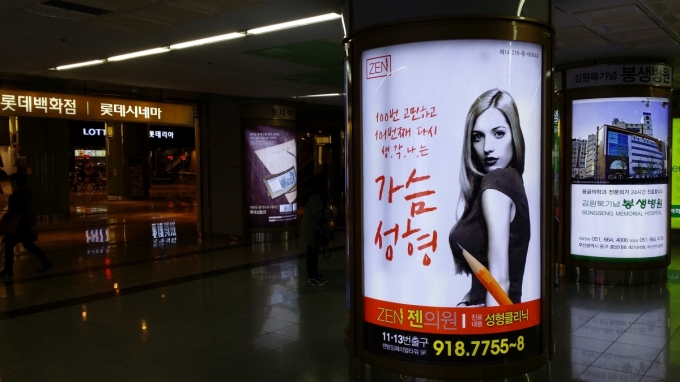 Exhausted after reading that? You’re not the only one(!). Yet that potted history of the taboo is still just the bare-bones, and needs considerable fleshing-out. Not least, from all the Korean-language sources I’ve also discovered and barely scratched the surface of, as well as the voices of Korean women and men themselves. I also acknowledge the almost complete lack of mention of men, and eagerly await your suggestions for further scholarly sources on Korean men’s nipples in particular ;)
Exhausted after reading that? You’re not the only one(!). Yet that potted history of the taboo is still just the bare-bones, and needs considerable fleshing-out. Not least, from all the Korean-language sources I’ve also discovered and barely scratched the surface of, as well as the voices of Korean women and men themselves. I also acknowledge the almost complete lack of mention of men, and eagerly await your suggestions for further scholarly sources on Korean men’s nipples in particular ;)
Despite all the generalizations and gaps however, a clear theme of fluidity and rapid change in Korea’s exposure taboos emerges from all the above, and there’s no reason to suppose those won’t continue. Indeed, to those that feel that women walking around with exposed breasts is too much of an extreme to ever return to, it was once considered just as outlandish for men to expose their chests too, as pointed out by activists in the Free the Nipple campaign:
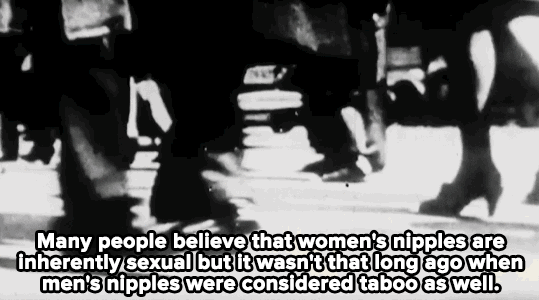


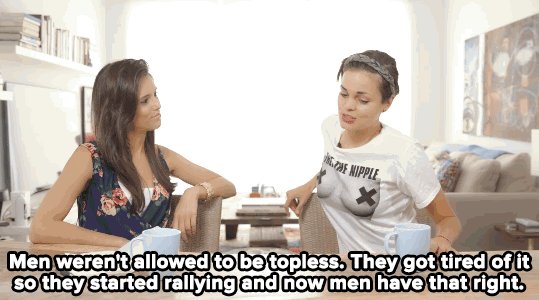

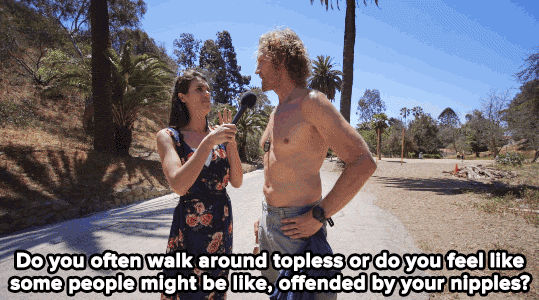



 Via: Astronomy in Reverse.
Via: Astronomy in Reverse.
Moreover, to those that feel that such a campaign has chances for success in Western countries, but that a Korean equivalent will inevitably lag far behind, I’d point out how recent the call for change is in Western countries too.* And nobody who was in a crowd of Red Devils in Korea in 2002—or, indeed, in a candlelight democracy vigil in 2017—can fail to appreciate what ordinary Koreans are capable of when decide they can no longer tolerate other people’s bullshit.
Kudos then, to the activists from Womenlink earlier this month. You can read more about their event (and see many more comments) in two posts on Womenlink’s Facebook Page, or on their homepage, and here’s my translations of their posters and placards to round off this post:
*As friends have rightly pointed out, the puritan standards of the US referenced in those links do not represent those of all Western countries. In particular, nude beaches have been popular in much of continental Europe for decades, and standards for the workplace and presenters on television are much more relaxed. Also, nudity is common on French daytime and primetime TV.
 Source: @womenlink.
Source: @womenlink.
(Speech Bubbles): Your nipples are showing! / Arrgh! (Women’s) Nipples! / Your nipples are too dark!
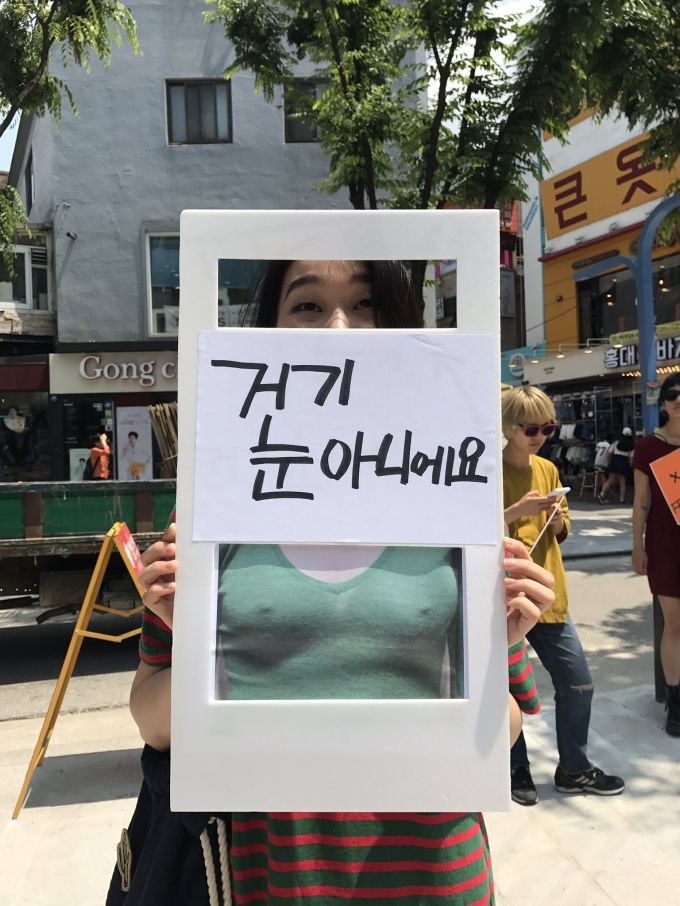 Source, this image and following 3: @womenlink.
Source, this image and following 3: @womenlink.
Those aren’t eyes there.
 (lit.) Nipples have a wide language.
(lit.) Nipples have a wide language.
 Source, this image and following two: @womenlink.
Source, this image and following two: @womenlink.
We wear padding (which isn’t ventilated) to hide our nipples, we wear bras to hide our breasts, to hide our bras we wear vests, and to hide our vests we wear t-shirts…this prickly heat is so frustrating! We can’t live like this! Free the Nipple!
 Q) If you have a lot of sexual experience, do your nipples get darker? A) No way!
Q) If you have a lot of sexual experience, do your nipples get darker? A) No way!
 Free the nipple / Why is looking at only women’s nipples restricted to over-18s?!?! Let’s stop the sexual objectification of women now!!
Free the nipple / Why is looking at only women’s nipples restricted to over-18s?!?! Let’s stop the sexual objectification of women now!!
Update: Korea Observer reported on a very similar event in 2014, although I’m unsure if it was connected with Womenlink in any way. Here’s a video from that:
The Revealing the Korean Body Politic series:
- Revealing the Korean Body Politic Part 12: If You Don’t Have Kim Yuna’s Vital Statistics, Your Body Sucks and You Will Totally Die Alone
- Revealing the Korean Body Politic, Part 11: 노출이 강간 유혹?…허튼소리 말라 Wearing Revealing Clothes Leads to Rape? Don’t Be Absurd
- Revealing the Korean Body Politic, Part 10: “An epic battle between feminism and deep-seated misogyny is under way in South Korea”
- Revealing the Korean Body Politic, Part 9: To Understand Modern Korean Misogyny, Look to the Modern Girls of the 1930s
- Revealing the Korean Body Politic, Part 8: The Bare-leg Bars of 1942
- Revealing the Korean Body Politic, Part 7: Keeping abreast of Korean bodylines
- Revealing the Korean Body Politic, Part 6: What is the REAL reason for the backlash?
- Revealing the Korean Body Politic, Part 5: Links
- Revealing the Korean Body Politic, Part 4: Girls are different from boys
- Revealing the Korean Body Politic, Part 3: Historical precedents for Korea’s modern beauty myth
- Revealing the Korean Body Politic, Part 2: Kwak Hyun-hwa (곽현화), Pin-up Grrrls, and The Banality of Sex and Nudity in the Media
- Bikinis, Breasts, and Backlash: Revealing the Korean Body Politic in 2012
If you reside in South Korea, you can donate via wire transfer: Turnbull James Edward (Kookmin Bank/국민은행, 563401-01-214324)

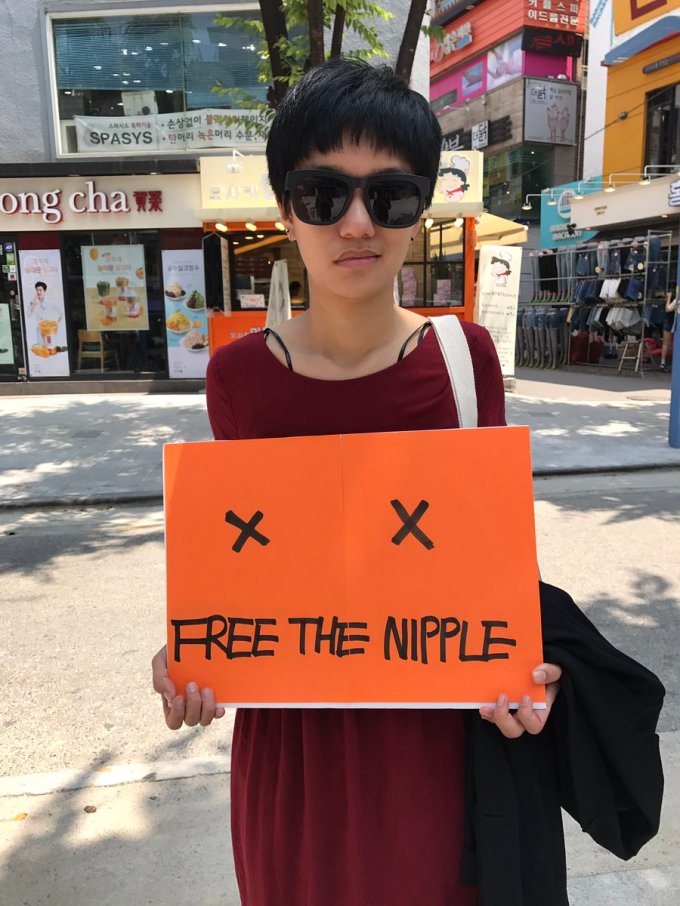


Breast size has increased with health? For fucks sake.
Boring.
LikeLike
Good point sorry. It’s been removed.
When I inserted the link about the difficulties of finding larger than average bras, I was thinking about similar reports about the difficulties of finding large clothes and shoes for both sexes, as the clothing industry in Korea seems to have only just started catering to the “new” demand. (FINALLY!) And Koreans’ height and feet size in general, I assumed, probably have increased in general because of improvements in healthcare, knowledge, and habits, in addition to diet. But that’s just a hunch of course, which may be mistaken, and does not automatically imply the same for breast size. So again sorry, because implying a link between an individual woman’s breast size and her health history was the exact opposite of my intention!
LikeLike
Don O’Brien, who took the 1945 photo mentioned in the post, died in January this year.
Here is an album with his other photos of Korea from 1945-46.
LikeLike
Oh, that’s sad to hear. I’ve been browsing his photos on and off for years, but missed that announcement.
Thanks for reading the post, and for the links.
LikeLike
I missed it as well until I read this post and popped over to his Flickr account.
LikeLike
even though I’m sure it was meant in an illustrative and innocent manner, when I was an 11 year old girl I wouldn’t have really wanted my parents to talk about my frustrations with my changing body publicly…just saying. otherwise I enjoyed this a lot:)
LikeLike
Thanks for your compliment, and I really do take your concern about my daughter to heart. Because I’ve got a much wider social media presence than most people, I’ve been really careful to keep my children out of it for a few years now. And even for those people who just share things between family and friends, I still think that once your children reach a certain age, you absolutely have to ask for their permission to post pictures of them and so on.
I admit that may make me sound hypocritical in deciding to keep the bit about my eldest daughter up then. But because it’s in English, doesn’t mention her name, and is hidden away in a long post, then it’s almost guaranteed that I’m the only person she knows who will ever read it. Also, that she’s well developed is obvious, and what she’s wearing under her t-shirts is kinda obvious to anyone that sits near her, so I’m not really revealing anything her friends don’t already know and can tease her about. Finally, in my bookcase next to me I have many books with similar types of observations about raising daughters, which like mine are there to raise parenting concerns and illustrate a point, so I’m in good company!
Sorry if all that overanalysis makes me sound defensive though! :)
It’s just that I really do worry about this sort of thing, especially as my trolls have gotten more vicious with me over the years and started extending their attacks against me to making slurs against my wife also (but not directly to her yet fortunately), so I really appreciate your comment for reminding me to think of my daughters’ feelings and safety. And you do make a good point. So, because of your comment, and because of what I just said about needing my daughters’ permissions, I will make this the very last time I’ll ever mention anything potentially embarrassing about them online–even if it is just in English.
Thanks again!
LikeLike
I have never worn padded bras because they dont fit my breasts shape. I was sometimes asked why am I not wearing a bra. I always wear an un-padded bra…
LikeLike
Thanks for your comment. But do you mean you were asked in Korea? Also, please forgive my ignorance about all the different bra types out there, but wearing un-padded bras means your nipples are more likely to be visible, right? So, that would imply that most Korean women wear padded bras to avoid that, regardless of comfort and their own breasts’ shape and so on?
If so, I can definitely understand the recent interest in bralettes, as mentioned in the post. But now I wonder if that interest will extend into actual sales, despite the inevitable questions like you received and demands by bosses that they wear something more “appropriate.” Unless–again, please forgive my ignorance–it’s still possible to hide your nipples while wearing them?
LikeLike